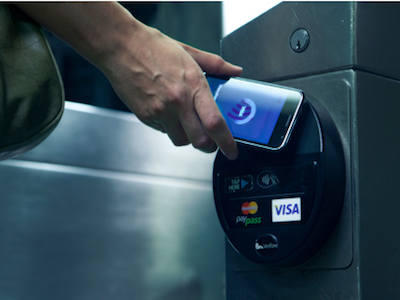Although near field communication (NFC) devices have been around for several years now, the recent advancements in smartphones, software and merchant technology have only just begun taking full advantage of the technology.
Google Wallet compatible smartphones are now able to make quick, wireless credit card payments at participating merchants with a simple wave of the phone. Products such as the U Grok It utilize NFC technology to help you track frequently misplaced items.
Now, researchers from Korea’s Sunchon National University, and the Paru Printed Electronics Research Institute have created a cheap method to make use of NFC-compatible devices.
Functioning similar to RFID (radio frequency identification) tags, the rectifying antenna utilizes an NFC-enabled smartphone's radio waves to generate DC power and transmit information back to the device.
“Our advantage over current technology is lower cost, since we can produce a roll-to-roll printing process with high throughput in an environmentally friendly manner,” one of the researchers, Gyoujin Cho explained. “Furthermore, we can integrate many extra functions without huge extra cost in the printing process.”
Estimated to cost approximately one cent per label, this particular "rectenna" can prove to be a cost-effective alternative to RFID tags. If more smartphones come equipped with NFC technology, the rectenna may become a convenient alternative to the QR code. Rather than snap a photo with a barcode scanning app, users will be able to wave their phone over a rectenna label to obtain its information.
For more information on the project, check out the research paper published in the Nanotechnology journal here.
Get Tom's Hardware's best news and in-depth reviews, straight to your inbox.
-
freggo rectenna... is it just me or is this a rather unfortunate choice for a product name ?Reply
Maybe it is just my dirty mind but 'rectal antenna' instantly jumps into my mind and I am now desperately trying to get it out of there :-)
-
mayankleoboy1 Replyinstantly jumps into my ass and I am now desperately trying to get it out of there :-)
corrected it for you :P
-
bigdog44 Reminds me of the Southpark episode where Cartman has a giant alien radio antenna sticking out of his ass. The data-miners decided they needed NFC because some people are too lazy to download an app or snap a picture...hey come to think of it, that southpark episode also had a herd of cows in it. Matt and Trey were way ahead of their time. : )Reply -
gsacks I just checked the calendar. It is not April 1st. This is supposed to be a real product? Fire the marketing guy NOW.Reply

